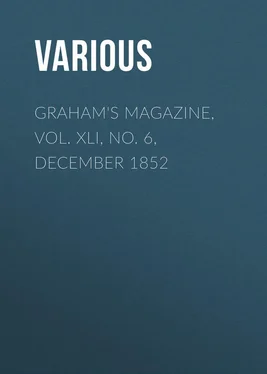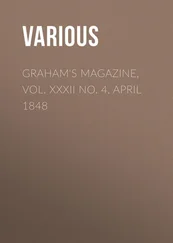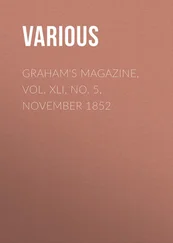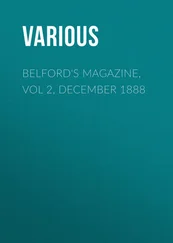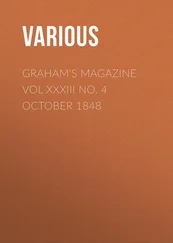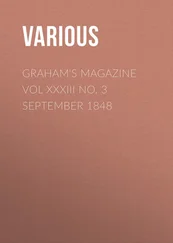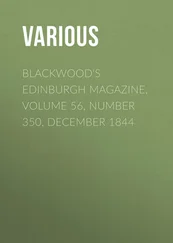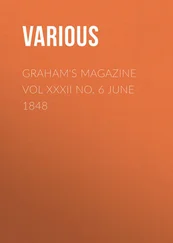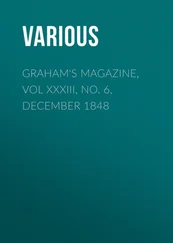Various - Graham's Magazine, Vol. XLI, No. 6, December 1852
Здесь есть возможность читать онлайн «Various - Graham's Magazine, Vol. XLI, No. 6, December 1852» — ознакомительный отрывок электронной книги совершенно бесплатно, а после прочтения отрывка купить полную версию. В некоторых случаях можно слушать аудио, скачать через торрент в формате fb2 и присутствует краткое содержание. Издательство: Иностранный паблик, Жанр: periodic, literature_19, foreign_edu, на английском языке. Описание произведения, (предисловие) а так же отзывы посетителей доступны на портале библиотеки ЛибКат.
- Название:Graham's Magazine, Vol. XLI, No. 6, December 1852
- Автор:
- Издательство:Иностранный паблик
- Жанр:
- Год:неизвестен
- ISBN:нет данных
- Рейтинг книги:3 / 5. Голосов: 1
-
Избранное:Добавить в избранное
- Отзывы:
-
Ваша оценка:
- 60
- 1
- 2
- 3
- 4
- 5
Graham's Magazine, Vol. XLI, No. 6, December 1852: краткое содержание, описание и аннотация
Предлагаем к чтению аннотацию, описание, краткое содержание или предисловие (зависит от того, что написал сам автор книги «Graham's Magazine, Vol. XLI, No. 6, December 1852»). Если вы не нашли необходимую информацию о книге — напишите в комментариях, мы постараемся отыскать её.
Graham's Magazine, Vol. XLI, No. 6, December 1852 — читать онлайн ознакомительный отрывок
Ниже представлен текст книги, разбитый по страницам. Система сохранения места последней прочитанной страницы, позволяет с удобством читать онлайн бесплатно книгу «Graham's Magazine, Vol. XLI, No. 6, December 1852», без необходимости каждый раз заново искать на чём Вы остановились. Поставьте закладку, и сможете в любой момент перейти на страницу, на которой закончили чтение.
Интервал:
Закладка:
Albert Durer – of whom the following cut is a fac-simile likeness, from a wood-engraving designed by himself – was born at Nuremburg, May 20, 1471, the son of Albert Durer, a goldsmith by profession, a Hungarian by birth.
In those days goldsmiths were artists of the highest order; necessarily sculptors, designers and engravers – witness Benevenuto, Cellini, and others, such as Bandinelli, and various great Italians, whom it would be too long to note, scarcely inferior.
Ambitious of greater things, Durer became apprentice to Michael Wolgemuth, the principal painter of his age and country; and, after having served his time, traveled, married unhappily, and died ere he reached old age, but not before he obtained world-wide, and time-defying renown, as a great painter, as more than a great copperplate-engraver – for it is only the greatest of the present day who are capable of producing fac-similes of his works – and, what most concerns us, as a great patron and promoter of wood-engraving.
That he was no wood-engraver himself, is we consider certainly proved, although by proofs negative.
They are briefly these.
The designs of the wood-cuts ascribed to Albert are in all respects equal to the designs of copper-engravings, known to be both designed and engraved by himself.
The execution and handling on his copperplates is superior to those of any other artist of his day.
Of his wood-cuts, while the designs are transcendent, the execution is ordinary; nor is there any perceptible variation between the execution of the cuts attributed to him, and those known to have been cut by Resch, from his designs.
The style of Durer’s drawing on wood shows the hand of a man used to copper; and is not that the best calculated for producing effects on wood.
Now it is scarcely credible, or even to be imagined, that an artist, who should have attained, himself almost untaught – for whoever they were, he manifestly surpasses all his teachers – such wonderful power and facility in engraving on one substance, should not, with equal practice on a different substance, have evinced the same – or at least some – superiority in handling it.
“There are about two hundred subjects, engraved on wood,” we quote, as before, from Jackson’s History of Wood-Engraving, “which are marked with the initials of Albert Durer’s name, and the greater part of them, though evidently designed by the hand of a master, are engraved in a manner which certainly denotes no very great excellence. Of the remainder, which are better engraved, it would be difficult to point out one which displays execution so decidedly superior as to enable any person to say positively that it must have been cut by Durer. The earliest engravings on wood with Durer’s mark are sixteen cuts illustrative of the Apocalypse, first published in 1498; and between that and 1528, the year of his death, it is likely that nearly all the others were executed. The cuts of the Apocalypse generally are much superior to all wood-engravings that had previously appeared, both in design and execution; but if they be examined by any person conversant with the practice of the art, it will be perceived that their superiority is not owing to any delicacy in the lines, which would render them difficult to engrave, but from the ability of the person by whom they were drawn, and from his knowledge of the capabilities of the art. Looking at the state of wood-engraving at the period when those cuts were published, I cannot think that the artist who made the drawings would experience any difficulty in finding persons capable of engraving them.”
It matters not, however, to the history of the art, whether Durer engraved, or did not engrave, with his own hand; it is sufficient for us to know, that it was he, and his friends and successors, who raised it to the position which it in their time occupied, and which, after a dark interregnum, it now occupies again, how high to soar hereafter we know not.
The works of Durer, “The Triumphal Procession of Maximilian,” in which he was a collaborateur with Hans Burgmair, The “Dance Macaber,” ascribed improperly to Hans Holbein, all executed nearly at this period, if they did not attain the highest attainable pitch of perfection, fell not at least far short of it. If, in after days, the skill of the manual workman has increased, the excellence of the designer is less marked – or, what amounts to the same thing, the best designers have not, until within the last half century, applied their talents to this art. At all events, and all things considered, we may assume with Mr. Jackson, that “at no time does the art appear to have been more flourishing, or more highly esteemed, than in the reign of its great patron the Emperor Maximilian.”
From the date of the appearance of the Dance Macaber, which is considered by good judges equal at least to any wood-cuts ever executed, the art began to decline. In England – later, perhaps, to receive it than the more early refined nations of the continent – it lingered through the reign of Elizabeth; but during the reign of the bestial Scottish despot who succeeded her, and his unhappy race, went out, like an exhausted lamp, for want of nutriment. The Italian school yet for awhile clung to existence, distinguished by inferior vigor, but by superior finish and neatness both of drawing and workmanship, and then perished, effete before mature, and never, we believe, has again revived.
How low the art of wood-engraving sunk after the commencement of the seventeenth century, and how small appeared the chance of its ever rising again from its ashes, may be seen at a glance; by comparing the specimens above, none of them pretending to be exemplars of the finest work of their several epochs, with the following miserable abortion, than which, it needs not now to say, no tolerable apprentice, of one year’s standing in a respectable office, could, unless he tried to do so, produce any thing worse either in design or execution.
And yet this is a very fair example of the style of wood-engraving from the reign of Charles II. to that of George III., with few exceptions. In a word, for some unaccountable reason, this noble art, as an art, had fallen every where – though nowhere, as some persons have fancied, either disused or forgotten – into desuetude, neglect, and contempt, from about the year 1700, until near the close of the eighteenth century. This, too, occurred at a period when, in many other sister branches, art stood as high, perhaps higher than ever, when Antony Vandyke, and Peter Joly, and Godfrey Kneller, and Joshua Reynolds painted, and copper-engraving had shown no decadence, but the reverse, either on the Continent or in England.
On the 10th of August, 1753, at Cherryburn, near Newcastle on Tyne, in Northumberland, was born, the son of a poor owner of a small landsale colliery, Thomas Bewick, who, by his own almost unassisted talents, raised this art, single-handed, from utter disgrace, and all but oblivion, to its very highest pitch of excellence – for in generic drawing and engraving especially, he never has found, and probably never will find, an equal. Designer, draughtsman, engraver, three in one, he has produced wood-cuts which never have been approached, and of which it has been said by competent authority, that “every line that is to be perceived in this, is the best that could have been desired to express the engraver’s perfect idea of his subject.”
It is said that as a boy this great man was employed as a laborer at his father’s coal-pit; but this may be dismissed as improbable at least, since he was early sent to school by his father at the Parsonage House of Ovingham, in an adjoining parish, and was subsequently, in compliance with his own desire, apprenticed to Mr. Beilly, an engraver at Newcastle, where, having by a mere accident of the office been employed to cut some mathematical diagrams on wood, he acquired a taste for the art sufficient to urge him on, without much encouragement, to its prosecution. Shortly after the expiration of his apprenticeship, he returned to his father’s house, and there applied himself earnestly to the study of the art in which he was ultimately to gain so much renown.
Читать дальшеИнтервал:
Закладка:
Похожие книги на «Graham's Magazine, Vol. XLI, No. 6, December 1852»
Представляем Вашему вниманию похожие книги на «Graham's Magazine, Vol. XLI, No. 6, December 1852» списком для выбора. Мы отобрали схожую по названию и смыслу литературу в надежде предоставить читателям больше вариантов отыскать новые, интересные, ещё непрочитанные произведения.
Обсуждение, отзывы о книге «Graham's Magazine, Vol. XLI, No. 6, December 1852» и просто собственные мнения читателей. Оставьте ваши комментарии, напишите, что Вы думаете о произведении, его смысле или главных героях. Укажите что конкретно понравилось, а что нет, и почему Вы так считаете.
